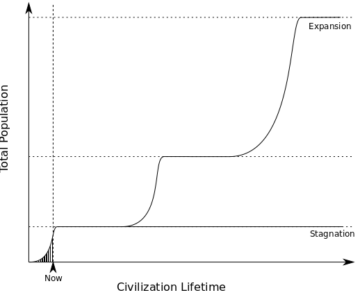by Jochen Szangolies

In 1950, during a lunch conversation with colleagues at the Los Alamos National Laboratory, Enrico Fermi asked the wrong question. Famously, after a discussion on the subject of recent UFO sightings, extra-terrestrial life, and the possibility of faster-than-light travel, Fermi blurted out: “But where are they?”
In that context, it was a sensible question: even given the magnitude of interstellar distances and the difficulties of bridging them, the vastness of cosmic time provides ample opportunity for an enterprising civilization to have visited any star within the galaxy several times over (for a brief recapitulation of the reasoning behind this assertion, see this previous essay). Certainly, it has been a stimulating one: it has spawned volumes of discussion, with potential solutions ranging from the optimistic to the dismal, from us inhabiting a carefully curated cosmic ‘zoo’ to every civilization self-destructing shortly after developing nuclear weapons.
But, as fruitful as this discourse has been, I want to suggest that there is a more interesting question that Fermi could have asked, one that might end up telling us much more about our place and future in the universe: “Why aren’t we them?”
Under seemingly reasonable assumptions, almost every sentient being in the universe should expect to find themselves as part of a galaxy-wide, ancient and prosperous civilization (the galactic metropolis); or, should interstellar space travel be fundamentally impossible, find whatever maximal niche they occupy (their ancestral home planet, the worlds of their solar system, a Dyson swarm around their star) filled nearly to capacity, for a time that’s of the order of magnitude of how long that niche can accommodate such a population. The argument for this is simply that for the vast majority of beings to ever exist, it will be true that they find themselves in such a situation, given ‘business as usual’—essentially, if life continues to ‘be fruitful and multiply’.
If it makes sense to apply such reasoning to our own situation (and I will argue that it does), the fact that we find ourselves very far from such a scenario demands explanation. Broadly, there are two possible answers. Either, we are just very ‘lucky’, part of that infinitesimal cohort that finds themselves at the margins of being—or business will not continue as usual: meaning, we will, in some sense, cease to fill every open niche with approximate copies of ourselves. The latter opens up two further options: pessimism and optimism. The pessimistic option amounts to (near-total) destruction, of any sufficiently advanced intelligent species, either by its own device or by others, perhaps through becoming visible as a potential threat that warrants a first strike.
However, the optimistic option is the one I will explore in this series. It involves, essentially, a transformation of life and mind as we know it, individual single streams of being coalescing into a vast ocean, mind breaking free from the bony brain-boxes that constrain it today to merge with the world around us, and even other minds within it. In this story, we are mental eukaryotes, single-celled organisms that house a nuclear mind insulated well within, before the evolution of multi-cellularity.
Thus, I will first argue that we appear to live in a very special time in cosmic history—that the circumstances in which we find ourselves, as an ascendant, young civilization at a liminal point in time, are very rare. Almost every sentient being will have a vastly different experience, given some apparently commonsense assumptions. I will then lay out conditions under which we should expect to find ourselves to experience this present moment—that is, conditions under which most sentient beings occupy corresponding moments, and thus, our present experience becomes typical. These are mostly rather bleak: either virtually every civilization dies out shortly after hitting this point, or we live in a simulation, or whatever succeeds us will not possess any kind of self-experience in the way we do (think advanced but unconscious AI, for example).
I will then draw on analogies from biology, history, information theory and thermodynamics to question the assumptions that yield this conclusion, which amount to questioning whether life and mind is truly best thought of as a collection of discrete individuals. Rather, I will argue that mind follows well-established trends of life, from the simple to the complex, climbing up the entropy gradient towards greater organization and interrelation, eventually being best described not in individual, but in holistic terms.
The Fall of the Berlin Wall
Enrico Fermi was a master of finding quick, approximate solutions to problems that seem to lack the information necessary to solve them. An emblematic such ‘Fermi problem’ is the question of how many piano tuners there are in Chicago: from rough estimates of population, the density of pianos, and how often they need to be tuned, one obtains a quick guess that’s often good enough within an order of magnitude. A more impressive case was his estimation of the yield of the Trinity nuclear bomb test using a few scraps of paper dropped in time to catch the blast wave.
Another feat of prediction from sparse data was performed by astrophysicist J. Richard Gott in 1969, when he was an undergraduate at Harvard. On a visit to the Berlin wall, he made the prediction that it would continue standing for no longer than 24 more years. The wall, of course, came down in 1989, well within Gott’s estimated timeframe.
What was the data that went into his prediction? Nothing more than the time that the wall had already stood up to the point of his visit—a rough eight years. Starting with this datum, he reasoned that the wall would stand between one third and three times that long again, with 50% confidence. The reasoning is simple: half of all visits to the wall will occur during half of its lifetime; therefore, half of all visitors will see it during that interval where it has stood between one quarter and three quarters of its total lifetime. Visiting it after one quarter has elapsed, it will stand for three times as long again; visiting it when it is three-quarters of the time to its eventual downfall, it will stand for another third of that time. Thus, half of all visitors to the wall will be right in claiming that it will stand no more than three times the time it stood so far.

There are two auxiliary assumptions that we have to make to arrive at the above prediction. First, we need to assume that we haven’t arrived at any privileged point in the wall’s history. Those taking to the wall with a sledgehammer after Günter Schabowski’s announcement opening the GDR’s borders would not reasonably predict it to continue standing for much longer. This is known as the Copernican Principle, the assumption that we occupy a perfectly ordinary spot in time (and space).
Second, the distribution of visitors to the wall over time needs to be approximately flat—there ought to be roughly as many visitors per unit of time across its entire lifetime. If most people see the wall shortly after it went up, and few bothered with it afterwards, then less than half of all visitors would see it in the right time period for the argument to yield a correct estimate. This is the Principle of Indifference. As long as we are justified in appealing to these two principles, we have a general recipe of predicting the lifetime of almost anything based only on the time it has been around so far.
The most famous application of this sort of reasoning—and definitely the most portentous—comes in the form of the so-called Doomsday Argument (DA), formulated originally by Australian theoretical physicist Brandon Carter in 1983 (later independently rediscovered and championed by Gott). The subject of this lifetime estimate is the human race itself: assuming that you are a perfectly ordinary member of said population (sorry), you should occupy a place between one quarter and three-quarters of the total number of human beings (again with 50% likelihood)—simply because half of all human beings, trivially, do. Thus, an upper bound on the total number of human beings is given by three times the number that have existed so far, and a date for doomsday is given by however long it takes to bring that many humans into existence. (One may, of course, vary the numbers here: for a 95% confidence doomsday, the upper bound is given by 20 times the aggregated human population; but the exact numbers won’t matter much for our purposes.)
It may seem counterintuitive that the mere fact of our existence at some particular point in time should allow us to draw conclusions about the human population in the far future. After all, the future’s defining characteristic is that it hasn’t happened yet—so how could we obtain (even probabilistic) knowledge about matters of fact still undecided?
Indeed, the DA is sometimes resisted on the basis that it seems to assume that we are somehow ‘drawn’ from the pool of all humans ever to be. But how exactly should one define this reference class? And how should one formulate a probability distribution according to which this draw occurs? But this is resolved by noting that half of all humans who could make this argument will be right, and you either are among that half—or you aren’t.
The point of this exercise is, now, that (depending on how exactly one slices the numbers) the total number of human beings yet to be born is perhaps a few hundred billion, which would yield a future lifetime for the human race of perhaps a few thousand years. This might seem reassuring, at first—with a couple thousand years to go, it seems we needn’t worry just yet. But in fact, it is shockingly soon, once on considers the cosmological timescales in play.
Waking up to the Future
Suppose you wake up one morning, suffering from a peculiar form of amnesia: while all of your abstract, scientific knowledge regarding the basic facts of cosmology is intact, the knowledge of your immediate surroundings, of the world you inhabit, is gone. (Perhaps you were out partying too long with the astrophysics department.) After you wake, what world should you expect to find yourself in?
You start from Fermi’s reasoning. Once life has secured its first tenuous foothold in the galaxy, exponential expansion should quickly—on cosmological scales, that is, on the order of tens of millions of years—see it disseminated to its furthest reaches. Given the rapid expansion of livable space and resources, a galactic civilization should contain vastly more individuals than were ever alive on the ancestral homeworld alone. Add to this the cosmological timescales that such a civilization might endure, and almost all sentient beings to ever exist should find themselves part of a vast, galaxy-spanning commonwealth, a galactic metropolis, with those few living before the jump to the stars barely being a rounding error. Thus, you conclude, with overwhelming likelihood, you, too, must be a part of a galactic community—a ‘mature’ civilization.

However, that’s a bit too quick. Interstellar spaceflight might be impossible, or simply too difficult to bother with. But then, still, a civilization might endure for billions of years on a planet orbiting a sun-type star—and conceivably hundreds of times longer, should intelligent life in stellar systems with a red dwarf be possible, due to their longevity. Most intelligent beings then will find themselves part of a civilization that is millions of years old.
No matter which of these obtains, eventually, your memory returns—and you recall yourself to be an inhabitant of present-day Earth: a planet-locked infant civilization that has just taken its first tentative steps beyond the atmosphere. How surprised should you be?
It’s hard to obtain a good estimate here that reflects anything beyond the bias of its originator. But for some nice, round numbers, about 109 billion humans have lived on the planet so far, and the total number until Earth is rendered inhabitable for humans about a billion years in the future might be a staggering 125 quadrillion—roughly a million times more. Thus, you’d find yourself among the first 0.0001% of humans ever—and that’s on the most conservative scenario, where we never set foot beyond Earth. Should we eventually reach for the stars, that number will decrease by many orders of magnitude.
Consequently, you find yourself at a very special, early point in time. Most intelligent beings to ever live will have a radically different experience, finding themselves rather part of ancient and vast civilizations. From this point of view, the DA is a means of attenuating this discrepancy: if humanity were to go extinct within the time period it suggests, your existence at this point in time would be exactly as expected.
Should we then resign ourselves to an end that, by whatever means, arrives much sooner than the natural boundaries on human existence would suggest? This is again too quick: for the argument to succeed, it need not merely be humans that fail to survive their civilizational infancy, but every race of sentient beings to come about. For in the above argument, no use was made of the fact that you are specifically human, at all—what was at issue was merely the typicality of your experience among all sentient beings to ever exist, that is, among all entities that could have any such experience at all. If humans were to fail to make it, but some race of small furry creatures from Alpha Centauri did, then still, the majority of sentient beings would experience existence as part of a mature civilization, making the fact that you don’t again cry out for explanation.
That seems to leave two options: either you just got ‘lucky’ (although how lucky you might consider yourself to be alive at this precise time, I’ll leave to your own judgment)—or most sentient entities find themselves being part of immature civilizations. The latter option, then, seems to imply that few, if any, civilizations survive to maturity. In terms of the Fermi paradox, this would indicate the existence of a ‘Great Filter’ in our (not too distant) future: some hurdle on the path towards becoming a mature civilization that’s just too high to clear, leading to no such civilizations existing in the galaxy as of yet (and possibly ever).

But things need not be that bleak. There are other options that make ours a typical experience for a sentient being. One is given by the so-called Simulation Argument (SA): originated by the Swedish philosopher Nick Bostrom, the SA alleges that most individual sentient experiences are those of simulated beings, and that hence, we ourselves are simulated with overwhelming likelihood. The argument is again one of simple numbers: with computation skyrocketing in terms of scale and efficiency, becoming more affordable all the while, large-scale simulations of humanity’s past—so-called ancestor simulations—eventually become trivially to instantiate. If then our future descendants are sufficiently motivated to create such simulations, there are likely to be many more simulated humans than ‘real’ ones; hence, each of us is more likely to be a simulation than not.
Now suppose that it is the liminal times when humanity stood just at the cusp of major developments that are likely of greatest interest—maybe the time before the invention of writing, and hence, reliable records; the preindustrial times; or, perhaps, the time before civilizational maturity in general. Thus, most simulations might be of such times, and hence, most of the simulated minds inhabit a ‘reality’ close to ours.
But there are important open questions surrounding this argument. Would a mature civilization consider it morally justifiable to instantiate trillions of feeling entities and consign them to a life of relative suffering (as compared to a life utilizing the resources of a mature civilization), just to satisfy their curiosity?
Moreover, would such a simulation actually fulfill its purpose? If the SA is as compelling as its proponents make it out to be, every simulated civilization should eventually conclude that they are, in fact, simulated. Would this not lead to behavior—say, appealing to the simulators to tweak a few parameters and lighten their daily burden—radically different from the real societies the simulation intends to explore?
Finally, is such a simulation actually possible? There are highly sophisticated (and fiercely debated) arguments opposing the possibility of creating conscious entities via mere computation.
However, I want to suggest that besides the unsatisfying explanation of sheer luck, the bleak future of the DA, and the questionable premises of the SA, there is another explanation for the apparent uniqueness of our experience that largely seems to have escaped notice, so far. There is a scenario in which humanity, in a broad sense, survives—meaning that there is no extinction event terminating our species—but not necessarily in the form of individual sentient entities. In this scenario, sentience undergoes an evolution broadly analogous to that of life itself, towards more complex forms; and one of the ways to increase complexity is to create compound minds, just in the way living cells come together to form large, multicellular creatures with a high degree of sophisticated structure. The age of individual minds—just as the age of individual cells—is then a transitory stage in the evolution of mind, and will eventually give way to a compound mentality encompassing billions or trillions of loci of mentation, just as your body encompasses trillions of cells. Thus, in the remaining entries to this series, I will flesh out these hints into a (hopefully) compelling picture for the future of mind in the cosmos.
Enjoying the content on 3QD? Help keep us going by donating now.
